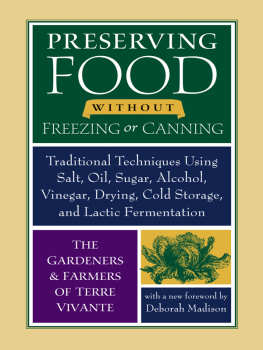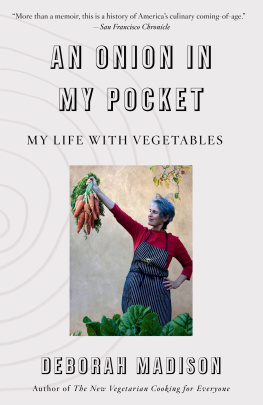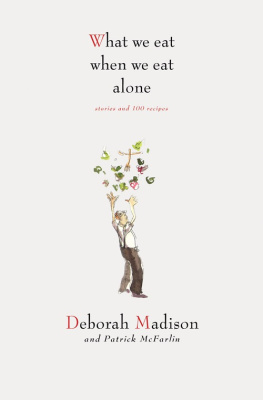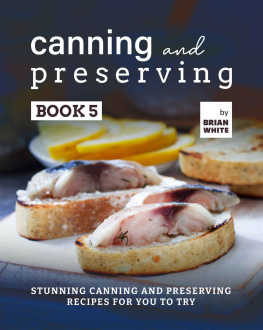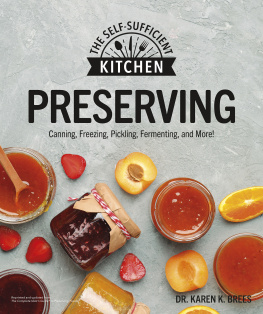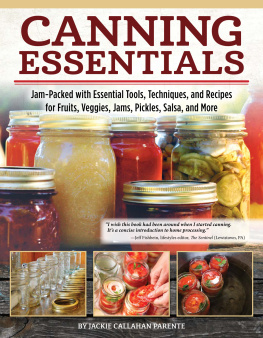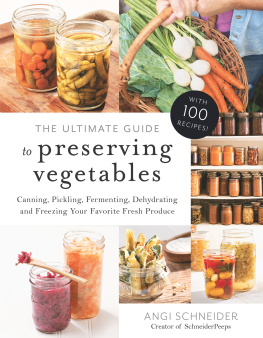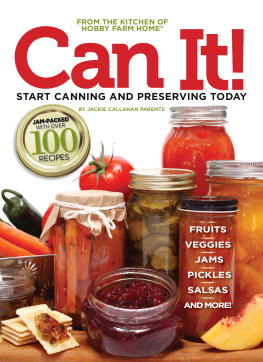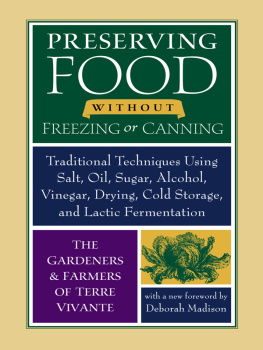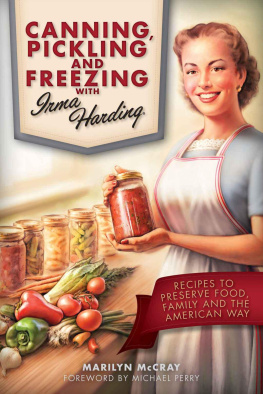
PRESERVING FOOD
WITHOUT FREEZING
OR CANNING


English translation copyright 1999 by Chelsea Green Publishing Company.
Illustrations copyright 1999 by Robin Wimbiscus.
Foreword by Eliot Coleman copyright 1999.
Foreword by Deborah Madison copyright 2006.
All rights reserved. No part of this book may be transmitted or reproduced in any form by any means without permission in writing from the publisher.
Book design by Molly Cook Field.
Translation by Diane Ct.
eBook ISBN: 978-1-603581-79-0
Printed in the United States of America.
First published in 1999 as Keeping Food Fresh.
New edition first printing, January 2007.
Originally published in 1992 in Paris by Terre Vivante.
09 08 07 5 4 3 2 1
Our Commitment to Green Publishing
Chelsea Green sees publishing as a tool for cultural change and ecological stewardship. We strive to align our book manufacturing practices with our editorial mission and to reduce the impact of our business enterprise on the environment. We print our books and catalogs on chlorine-free recycled paper, using soy-based inks whenever possible. Chelsea Green is a member of the Green Press Initiative (www.greenpressinitiative.org), a nonprofit coalition of publishers, manufacturers, and authors working to protect the worlds endangered forests and conserve natural resources.
Preserving Food Without Freezing or Canning was printed on Natures Natural, a 50 percent post-consumer-waste recycled, old-growth-forest-free paper supplied by Thomson-Shore, Inc.
The Library of Congress has catalogued the previous edition as:
Conserves naturelles des quartre saisons. English.
Keeping food fresh : old-world techniques and recipes : the gardeners and farmers of Terre Vivante.
p. cm.
1. FoodPreservation. I. Aubert, Claude.
II. Terre Vivante. III. Title.
TX601.C643 1999
641.4dc21
99-35132
CIP
Chelsea Green Publishing Company
P.O. Box 428
White River Junction, Vermont 05001
(802) 295-6300
www.chelseagreen.com
CONTENTS
Foreword to the New Edition
IN THE PRESENCE OF THE PAST
by Deborah Madison
Foreword to the First Edition
THE POETRY OF FOOD
by Eliot Coleman
Preface
HOW THIS BOOK CAME TO BE
Introduction:
PRESERVATION WITHOUT NUTRIENT LOSS
Chapter 1
PRESERVING IN THE GROUND OR IN A ROOT CELLAR
Chapter 2
PRESERVING BY DRYING
Chapter 3
PRESERVING BY LACTIC FERMENTATION
Chapter 4
PRESERVING IN OIL
Chapter 5
PRESERVING IN VINEGAR
Chapter 6
PRESERVING WITH SALT
Chapter 7
PRESERVING WITH SUGAR
Chapter 8
SWEET-AND-SOUR PRESERVES
Chapter 9
PRESERVING IN ALCOHOL
Appendix
WHICH METHOD FOR PRESERVING EACH FOOD?
Foreword to the
New Edition
IN THE
PRESENCE OF
THE PAST
BY D EBORAH M ADISON
I LIVE ON A DIRT LANE IN A SMALL, historic New Mexican village. In the middle of the lane is a place where raised stones mark the sides of a six-foot square. I had driven over these stones for years, wondering what they might signifyan old well or perhaps a cistern?until I happened to have a chat with my neighbor, Modesta. In the course of discussing all our wormy apples, she told me how people here used to store food for the winter, chiles and other vegetables, in pits of sandy soil. Like that, she said, pointing to the patch of stones. That was a storage pit. There are lots of them around here. And it was probably used not that many generations back.
Its good to know how people have, through time, preserved their foodto have a window to view the old techniques and traditions. PreservingFood Without Freezing or Canning gives us just this opportunity. The methods here may well inspire us with their resourcefulness, their promise of goodness, and with the idea that we can eat well year around and quite independently of our long-distance food systems. Mostly whats required is curiosity and the willingness to use some elemental toolsair and sun for drying, the earth for holding, salt for transforming and preserving, paper for wrapping, oil for banishing air, ashes for preserving freshness. These basic things are the stuff of old-world techniques, and not all are in the past.
The oldest technique for preserving food, drying, is still used in New Mexico. Corn is roasted or slaked with lime and then dried in the sun on tin roofs or wire screens. Chiles are dried then ground to make molido, less commonly apples are sliced and dried on strings on clotheslines. The long red ristras of chiles are still stored food even if they now have the dual role of ornamenting homes. On the farm they hang from the eaves of barns where the dry air passes freely around them, discouraging mold. A ristra placed in the kitchen makes it easy to pluck off chiles when cooking. Although green chiles are no longer buried in sand pits like the one in my lane, two techniques for doing so are described in this little book, should you want to try. Covering food with earth, drying it in the air, fermenting it in salt, burying it in fatall traditional techniques of food preservationshould not be so impossibly far from our plates and palates today as we might, at first thought, assume.
Its tempting, if one is nervous about the future, to say that its good to know about the old ways of putting food by because we might need to know about them someday, just to survive. True, this could be a life-saving book, but this isnt the main reason to read it. There are good reasons that dont involve an uncertain future, those that have to do with taste and flavor, processes that preserve nutrition, such as lactic fermentation, as well as pleasure and poetry. One of my favorite descriptions in Preserving Food WithoutFreezing or Canning, a method for storing apples, involves wrapping them in dried elderflowers. Imagine the pleasure of being sent to retrieve such an apple, brushing off the still-fragrant flowers, discovering that the fruit has changed from an apple to something mysterious and enchanting. Or, consider how simple is it to wrap tomatoes in paper to extend their prevcious season where frosts come early. This is a book I turn to when I find myself with a bounty of fruit. It guides me with the most direct ways to transform fruit into jellies and syrups, chutneys and preserves, without drowning it in sugar or killing it with pasteurization. The combinations are subtle and poetic, not quiet like others Ive encountered. Take, for example, Melon Marmalade with Mint, Pear Jam with Walnuts, Blackberry Jam with Hazelnuts, or Cinnamon Dark Red Plums preserved in vinegar. The Bicolored Grapes in Vinegar are said to be divine with gamehow enticing. I have some venison; where are the grapes? We all have these fruits and nuts, but what different ways of aligning them are given here. There are also foods we might have but really dont know how to use, like buckthorn berries, linden flowers, elderberries, and wild greens and mushrooms, but can learn about should we encounter them. Thinking of the velvety winter oyster mushrooms in my farmers market that will, in fact, not last the winter unless I dry them, I am happy to know how to go about it.
Next page
